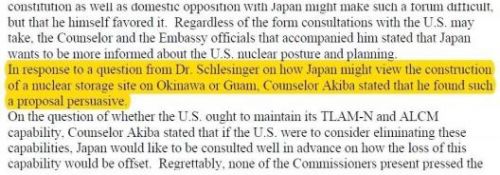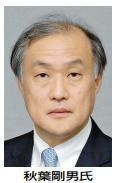Foreign Affairs Vice-Minister Akiba denies making his 2009 statement that proposing nuclear storage site on Okinawa or Guam would be “persuasive,” recorded in U.S. Congressional memo

The memo from the Congressional Commission on U.S. Strategic Posture at the time of the discussion in February 2009, which summarizes Akiba’s statement that he would find a proposal for construction of a nuclear storage site on Okinawa or Guam to be persuasive.
March 6, 2018 Ryukyu Shimpo
By Washington Special Correspondent Yukiyo Zaha
The U.S. Congress established the Congressional Commission on U.S. Strategic Posture, chaired by former Secretary of Defense William Perry. This Commission was tasked with developing the former Obama administration’s Nuclear Posture Review (NPR), a road map for nuclear strategy policy. When the Commission held a discussion with Japan, a minister at the Embassy of Japan in Washington at the time, Takeo Akiba, answered an inquiry from the Commission’s vice chairman about a nuclear weapons storage facility in Okinawa. Akiba said the proposal seemed “persuasive” and showed support for such a facility.
This statement was confirmed through a memo from the Commission, which was obtained by Gregory Kulacki. Kulacki is a top analyst of the Union of Concerned Scientists, a group comprised of U.S. scientists. Kulacki issued a warning to Okinawa that it may host nuclear weapons once again, through construction of the new base in Henoko, Nago, and the potential reopening of the Henoko Ordnance Ammunition Depot.

Takeo Akiba
This discussion took place in February 2009 under the Aso administration. In January this year, Akiba was appointed as the Vice-Minister for Foreign Affairs. On March 5, Akiba and the Ministry of Foreign Affairs denied his statement, declaring that Akiba said no such thing.
According to the memo, the Congressional Commission on U.S. Strategic Posture’s Vice Chairman James Schlesinger (former Secretary of Defense) asked Akiba how Japan might view the construction of a nuclear storage site on Okinawa or Guam. Akiba replied that he would find such a proposal to be “persuasive.”
Also, a document that Akiba submitted to the Commission contained a request pushing the U.S. toward low-yield nuclear options, among other things. The contents of the Trump administration’s NPR released in January are in line with that objective. Minister of Foreign Affairs Taro Kono says he “highly appreciates” the NPR, and that the Abe administration supports it. Kulacki thinks it is essential to investigate the likelihood of the U.S. and Japan agreeing to store U.S. nuclear weapons in Okinawa.
In the past nuclear weapons were stored at the Henoko Ordnance Ammunition Depot and Kadena Ammunition Storage. During negotiations for the return of Okinawa to Japanese sovereignty, a secret agreement was concluded which allows for redeployment of U.S. nuclear weapons to Okinawa. Also, the Marine Corps 2014 Integrated Natural and Cultural Resources Management Plan specified redesigning and expanding Camp Schwab and the Henoko Ordnance Ammunition Depot in order to handle new functions. It seems likely that thirteen ammunitions depot buildings will be dismantled, and twelve new depots and weapons assembly areas will be established. In November last year the U.S.-Japan Joint Committee agreed to dismantle four of the thirteen buildings. The Japanese government is responsible for about two billion yen of the costs, and reconstruction is expected to start within a year.
(English translation by T&CT and Erin Jones)
Previous Article:Editorial: Missile defense unit on Okinawa’s main island is an overreaction that invites danger
Next Article:12,410 runners hit the streets on a clear and sunny day for the Okinawa Marathon
[Similar Articles]
- Reconstruction work of Henoko ammunition storage facilities continues
- Civilian and U.S. military buildings surrounding Henoko base exceed civil aeronautics and U.S. military height restrictions
- American scientist visits Henoko to support protesters
- 30 meter landslide in Henoko near ammunition depot
- Forty years after the removal operation of stocks of U.S. poison gas, a representative of residents says, “We live still close to the munitions depot”
 Webcam(Kokusai Street)
Webcam(Kokusai Street)


